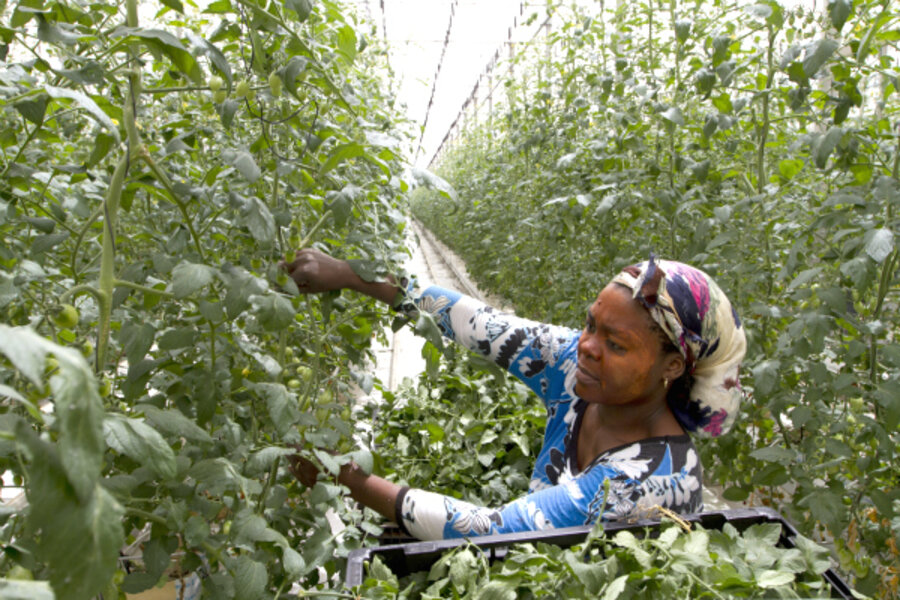In Africa, producing food from waste
Loading...
In sub-Saharan Africa where nearly a third of the population is hungry, over a quarter of food produced is lost to spoilage. And the hundreds of millions of livestock on the continent are responsible for degrading almost half of crop land on the continent, which makes up over one-third of overgrazed lands worldwide.
But the uneaten food, manure, and other forms of waste are being used by farmers to produce fertilizer, fuel, and food.
South Africa has been diverting organic matter from its landfills since 1969. About 2 percent of waste generated in Cape Town, and 15 percent in Johannesburg, is diverted through composting.
In Johannesburg, compost sales were projected to completely offset production costs by 2006. Two other municipalities operate smaller-scale composting facilities in the country. A project funded by the World Bank in Uganda has nine municipalities establishing composting plants.
Composting food waste relieves pressure on landfills while producing an inexpensive, nutrient-rich soil amendment that farmers use to improve soil fertility. Compost adds organic matter to the soil, increasing the water-holding capacity of its structure, facilitating root penetration and making nutrients available to crops over time.
Subsistence farmers have traditionally relied on composting and livestock manure to improve soils. The Ibo tribe of Nigeria, for example, used branches from trees for mulching, applied goat dung to individual plants, and composted human waste as early as the 1970s. In Zimbabwe, farmers traditionally graze cattle during the day and contain them in pens at night so that they can collect the manure and spread it over farmland.
A number of projects have been teaching farmers across the continent how to compost and improve the quality of compost produced. A participatory radio show in the Zégoua region of Mali resulted in a 64 percent increase in household adoption of composting. In Kenya, a demonstration project turned waste from households, vegetable markets, and an avocado processing plant into compost that farmers could use to increase crop yields or sell. And farmers in Pelungu, Ghana, are building goat shelters with sloped floors that transport dung into a central location using gravity. The manure is then composted and used on farms.
Most livestock waste in the urban slums of Kisumu in western Kenya goes unused and accumulates in the city. The dung poses a health hazard, entering the city’s water supply when it rains. Some residents have been using the dung as a mosquito repellent, and more recently the pastoralist tradition of using dung as fuel is catching on in the city. Combined with other ingredients to form a briquette, the dung is being recycled into cooking fuel that lasts longer, and burns cleaner, than alternatives like charcoal.
Making and selling the briquettes has turned into an income source for some farmers. An alternative to briquettes, a biogas digester invented in the country, transforms cow dung and weeds such as water hyacinth into fuel and fertilizer with the help of microorganisms.
Manure and agricultural waste is also being used as fish food. Christopher Mwita of the Tarime District in Tanzania established an “integrated fish management” system in 2005 that produces fish from farm waste and fertilizer from fish waste by integrating the production of catfish and tilapia with poultry, maize, rabbit, and vegetable production. Chickens walk on stalks that enable nitrogen-rich droppings to fall directly into the fish pond, the enriched water is used to irrigate crops, and the crops feed livestock.
African catfish and tilapia, popular species in aquaculture systems around the world for their hardiness, are native to African lakes. In Zambia, a pig farm is also the country’s largest fish farm, using waste generated by the pig operation to feed fish.
• Kim Kido is a research intern with the Nourishing the Planet project.
• To purchase your own copy of "State of the World 2011: Innovations that Nourish the Planet", please click HERE. And to watch the one-minute book trailer, click HERE.
• This article first appeared at Nourishing the Planet, a blog published by the Worldwatch Institute.





